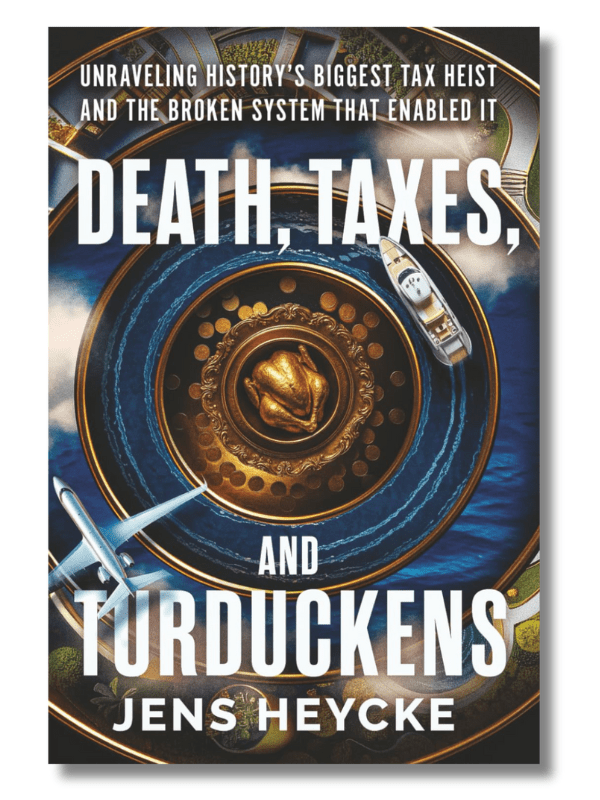Death, Taxes, and Turduckens
by Jens Heycke
Genre: Nonfiction / True Crime
ISBN: 9798288536526
Print Length: 182 pages
Reviewed by Erin Britton
A shocking account of theft on a scale that shows reality can be stranger than fiction
Jens Heycke’s Death, Taxes, and Turduckens: Unraveling History’s Biggest Tax Heist… reveals some mind-boggling financial misappropriation. Building on a solid factual foundation, Heycke wraps this tale of an audacious scheme to defraud the US government in an always surprising, sometimes thrilling package.
The book begins at the end—the end of 83-year-old Houston-based tax attorney Carlos Kepke, that is. “For his entire professional life, Kepke had battled one of what Benjamin Franklin had famously called life’s only uncertainties: taxes.” He took the battle so seriously in fact that he allegedly helped clients avoid paying hundreds of millions of dollars in taxes. After being indicted for facilitating tax evasion, Kepke shot himself.
The untimely demise of Kepke makes for a startling opening to Death, Taxes, and Turduckens, reflecting the unusually cinematic style of the book when compared with other tax-based nonfiction works. Heycke’s narrative adopts a decidedly person-centric approach, stressing the personalities and motivations of those involved, in addition to the technical aspects of the fraud.
Indeed, the first part of the book is dedicated to the saga of the fraud emanating from Kepke’s tax practice, encompassing the fates of some of his most prestigious clients. At the center of this web of financial deceit is Robert Brockman, the billionaire founder of Universal Computer Systems, who somehow managed to own nearly zero assets—on paper, anyway. But how?
The unlikely answer is turduckens.
For those with insufficient resources to even bother with tax evasion, Heycke provides a neat explanation of the turducken phenomenon: “These are intricate off-shore structures, meticulously engineered to make fortunes invisible and, therefore, untaxable.” Basically, to mask the ultimate ownership and value, multiple entities are stuffed within other entities and distributed around the world.
But before a turducken becomes appetizing, billions of dollars have to be accrued so that they can subsequently be hidden. To illustrate how this can come about, Heycke provides brief biographies of two very different billionaires: Robert Brockman and Robert Smith. The overview he provides of their childhoods, educations, career paths, and business innovations neatly explains how they gained their fortunes and came to collaborate.
However, while their joint venture with Vista Equity Partners certainly proved lucrative, they had vastly differing approaches to life and business. “Smith’s public image as a brilliant investor, generous mentor, and charismatic philanthropist provided a sharp contrast to Brockman’s secretive and tyrannical reputation.” As Heycke explains, this difference caused the schism that led to Smith assisting the IRS in exposing Brockman’s fraud.
While the back-stabbing, double-crossing, and paper-pushing involved come as no surprise, Heycke’s account highlights the surprisingly action-packed (and sometimes rather silly) nature of the fraud and the operation to end it. “It unfolded with the dizzying twists of a spy thriller, with encrypted messages embedded in digital photos, clandestine codenames, and high-stakes betrayals that shifted fortunes overnight.”
The way Heycke describes things certainly means there’s no danger of a tax-based topic seeming dry or boring. There’s also a great deal of peril involved. “The immense pressure of looming indictments, the specter of public disgrace, and the crushing weight of financial ruin push many to desperation. Suicide is not uncommon.” It’s almost enough to put a person off tax evasion.
Interspersed with anecdotes about (in)famous tax evasion cases, as well as startling facts and figures (“Each year, honest taxpayers shoulder a staggering $447 billion burden left behind by those who cheat.”), the story of Kepke and Co.’s fraud in the first part of Death, Taxes, and Turduckens offers a fascinating account of the lengths people will go whether to hide a fortune or to recover one.
The light Heycke shines on the under-scrutinized and little-publicized work of the IRS is particularly interesting. He explains how IRS investigators fight back with things like sting operations, whistleblower payouts, and forensic accounts. Heycke also suggests ways in which the United States tax system could be reformed so that frauds—of the turducken variety or otherwise—can be more effectively prohibited and those who continue to pursue such an approach to their finances can be more effectively (or to any extent at all) punished.
Whether it’s going after the ultra-rich rather than easy targets such as waitresses struggling to get by on tips, or simplifying the rules and strengthening enforcement, or even lowering tax rates to reduce the incentive to cheat, Heycke’s ideas seem sound and backed by a thorough understanding of tax law and practice. Whether the IRS would agree to any of them is another matter entirely.
By setting the scene worldwide and exploring the various loopholes there to be exploited, Heycke presents pragmatic ways in which fraud can be stymied and cheats caught, and he posits means of increasing the IRS’s power and reach. This part of the book is quite thought-provoking, if less thrilling than the first part, forcing us to ask questions about financial regulation and the (desirable) remit of government agencies.
Heycke’s thesis in this regard is based on a simple idea: “‘The House’ can and should win. Not by luck, but by design: by building a tax system that is fair, simple, and trusted.” Death, Taxes, and Turduckens is an eye-opening true story about what goes on behind closed (tax office) doors.
Thank you for reading Erin Britton’s book review of Death, Taxes, and Turduckens by Jens Heycke! If you liked what you read, please spend some more time with us at the links below.
The post Book Review: Death, Taxes, and Turduckens appeared first on Independent Book Review.
